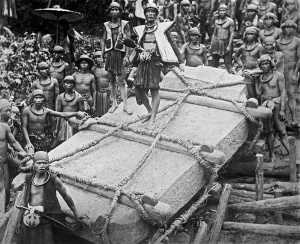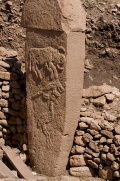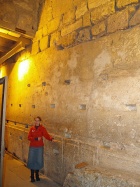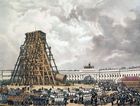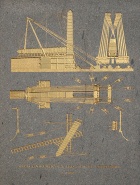Lista dei più grandi monoliti al mondo
Da Ufopedia.
| Questa voce ha bisogno di essere tradotta. |
This is a list of monoliths organized according to the size of the largest block of stone on the site. A monolith is a large stone which has been used to build a structure or monument, either alone or together with other stones. In this list at least one colossal stone over ten tons has been moved to create the structure or monument.
In most cases the ancient civilizations had little, if any, advanced technology that would help the moving of these monoliths. The most notable exception is that of the ancient Greeks and Romans who had cranes and treadwheels to help lift colossal stones (see List of ancient monoliths).
Documented in recent times, there is a list of efforts to move colossal stones that used technology that wasn't more advanced than the technology the ancient civilizations used.
Most of these weights are based on estimates by published scholars; however, there have been numerous false estimates of many of these stones presented as facts. To help recognize exaggerations, an introductory description shows how to calculate the weight of colossal stones by calculating volume and density.
Indice |
Calculating the weight of monoliths
In the cases of the smaller monoliths it may be possible to weigh them. However in most cases the monoliths were too large or they may have been part of an ancient structure so this method could not be used. The weight of a stone can be calculated by multiplying its volume and density. The density of most stones is between two and three tons per cubic meter. The average weight of granite is about 2.75 metric tons per cubic meter, limestone 2.3 metric tons per cubic meter, sandstone or marble 2.5 tons per cubic meter.[1][2][3][4][5] Some softer stones may be lighter than 2 tons per cubic meter like volcanic tuff or basalt which weighs about 1.9 tons per cubic meter.[6][7] Since the density of most of these stones fluctuates it is necessary to know the source for the stone and volume to obtain accurate measurements.[8][9]
Rock density
The discussion above is accurate as far as it goes, which is only to the first significant figure. To go any further one needs to be relatively sophisticated about surveying the monolith (including realistic and explicit assessment of the shapes of inaccessible portions of the monolith), then about calculating the volume (and volumetric errors, which vary crudely as the cube of linear uncertainties). Finally and crucially the rock density needs to be measured with appropriate precision. Identifying the rock type is not going to be sufficient as this table (from[10]) illustrates:
| Material | Density |
|---|---|
| Sediments | 1.7–2.3 |
| Sandstone | 2.0–2.6 |
| Shale | 2.0–2.7 |
| Limestone | 2.5–2.8 |
| Granite | 2.5–2.8 |
| Metamorphic Rock | 2.6–3.0 |
| Basalts | 2.7–3.1 |
Simply identifying the monolith as being "sandstone" would allow a reasonable ± 15% uncertainty in the weight estimate. In practice, one would measure the density of the monolith itself, and preferably document any variation in density within the monolith as they are made of natural materials, which have not been engineered for homogeneous parameters. Non-destructive methods of density measurements are available (e.g. electron back-scatter); alternatively the site may contain already-separated fragments of the monolith which can be used for laboratory measurements or on-site techniques. At the crudest, a weighing device and a bucket can obtain two significant figures for a density value.
Quarried monoliths
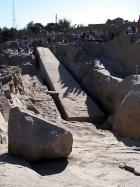
This list includes only quarried, but not moved monoliths.
| Weight | Name/Site | Type | Location | Builder | Comment |
|---|---|---|---|---|---|
| 124,200 t[11] | Unnamed monolith | Block | Baalbek, Lebanon | Roman Empire | 19.5–20.5 m long, 4.34–56 m wide, 4.5 m high |
| 110,000 t[12] | Unfinished obelisk | Obelisk | Assuan, Egypt | Ancient Egypt | 41.75 m long, 2.5–4.4 m wide |
| 100,000 t[13] | Stone of the South | Block | Baalbek, Lebanon | Roman Empire | 20.31–76 m long, 4–5.29 m wide, 4.21–32 m high |
| 20,700 t[14] | Granite column | Column | Mons Claudianus, Egypt | Roman Empire | Ca. 17.7 m (59 feet) long[15] |
Moved monoliths

This list includes only quarried and moved monoliths.
| Weight | Name/Site | Type | Location | Builder | Comment |
|---|---|---|---|---|---|
| 1,250 t[16] | Thunder Stone | Boulder | Saint Petersburg, Russia | Russian Empire, 1770 | Moved 6 km overland for shipment,[16] and cut from 1,500 t to current size while on transport[17] |
| 1,000 t[18][19] | Ramesseum | Statue | Thebes, Egypt | Ancient Egypt | Transported Template:Convert by ship from Aswan |
| 800 t each[20] | Trilithon (3x) | Blocks | Baalbek, Lebanon | Roman Empire | Plus about 24 blocks 300 tons each[21] |
| 700 t each | Colossi of Memnon (2x) | Statues | Thebes, Egypt | Ancient Egypt | Transported Template:Convert from el-Gabal el-Ahmar (near modern-day Cairo) over land without using the Nile.[18][19][22] |
| 550 to 600 t[23][24] | Western Stone, Jewish Holy Temple | Block | Jerusalem, Israel | Herod, King of the Jews during the Second Temple period | |
| 520 tons, 170 tons and 160 tons | Great Stele, King Ezana's Stele, Obelisk of Axum | Stelae | Axum, Ethiopia | The stelae were moved about Template:Convert.[18] | |
| 400-600 t | Gomateshwara | Statue | Hassan district of Karnataka state, India | 60 feet (18 m) tall over 30 feet (9 m) wide | |
| 400 t[25] | Temple in complex for Khafre's Pyramid | Giza, Egypt | |||
| 300-500 t[26] | Masuda no iwafune | Asuka, Nara, Japan | large stone structure approximately 11 meters in length, 8 meters in width, and 4.7 meters In height | ||
| 340 t[27] | Levitated Mass | Los Angeles, California, United States | Large stone intended for a work of art, Moved 106 miles.[28] | ||
| 300 t[18] | Broken Menhir of Er Grah | Brittany, France | Moved Template:Convert. | ||
| 285 t[29] | Pompey's Pillar | Column | Alexandria, Egypt | Roman Empire | |
| 230 t[30] | Mausoleum of Theodoric | Roof slab | Ravenna, Italy | Ostrogothic Kingdom | |
| 220 t[31] | Menkaure's Pyramid | Giza, Egypt | largest stones in mortuary temple | ||
| 200 t[32] | Sahure's pyramid | Saqqara, Egypt | largest stones over king's chamber | ||
| 200 t[33] | Gochang, Hwasun and Ganghwa Dolmen Sites | Korea | largest stone | ||
| Weight | Name/Site | Type | Location | Builder | Comment |
- Cueva de Menga, in Antequera, Spain. Dolmen made of megaliths, weighing up to 180 tons.Built in 2500 BC.
- Colossal statue of Tlaloc, in Coatlinchan. Made of basalt, weighing 168 tons.[34][35][36]
- The Kerloas menhir, Brittany, France. Largest, 150 tons.[37]
- Dol-de-Bretagne, France. Menhir, almost 150 tons.Template:Cn
- Pyramid of Khendjer at Saqqara, Egypt. 150-ton, one-piece quartzite burial chamber.[38][39]
- Tiwanaku, Bolivia. Several ashlars, 100 to 130 tons, were transported Template:Convert.[40][41]
- Sacsayhuamán, wall near Cusco, Peru. Largest stones over 125 tons.[42][43]
- Treasury of Atreus at Mycenae, Greece. Largest lintel stone, 120 tons.[42]
- The Pyramid of Amenemhet III, at Hawara, Egypt. 110-ton, one piece quartzite burial chamber.[44][45][46]
- Luxor, Egypt. Obelisk, 227 tons. The largest colossal statue of Ramses, well over 100 tons.Template:Cn
- Ollantaytambo, Peru. Perhaps 6 stones well over 100 tons.Template:Cn
- Brownshill Dolmen, weighing an estimated 100 metric tons.[47]
- Baths of Caracalla, Rome, Italy. Granite columns close to 100 tons.[42]
- Hagia Sophia in Istanbul, Turkey. Columns close to, if not more than, 100 tons.Template:Cn
- Fortress of Mycenae, Greece. Largest stones close to 100 tons.[42]
- Pyramid of Nyuserre Ini. 12 megalithic limestone beams 10 meters long weighing 90 tons each, forming the roof of burial chamber and antechamber.[48]
- Moai at Easter Island. Largest Moai 70 to 86 tons. The tallest one, Paro, was moved Template:Convert.[49]
- Great Pyramid of Giza, Egypt. Largest slabs on burial chamber, 80 tons. The granite was transported Template:Convert from Aswan by barge on the Nile river.[42]
- Karnak, Egypt. Obelisk, 328 tons. Largest architraves, 70 tons. Sandstone transported from Gebel Silsila Template:Convert.[50][51]
- Trajan's Column, Rome, Italy. Pedestal blocks: 77 t[52]
- Ishibutai Kofun in Asuka, Nara, Japan. Largest stone, 75 tons.[53]
- Quirigua, Guatemala. Largest stele, 65 tons.Template:Cn
- Osireion Abydos, Egypt. Columns and lintels, about 60 tons.Template:Cn
- Pantheon, Rome, Italy. Granite columns, 39 feet (11.8 m) tall, five feet (1.5 m) in diameter, and 60 tons in weight were transported from Egypt by barge.[42][54]
- Olmec heads, Mexico, gulf coast. Largest Olmec head, almost 50 tons. Transported 37 to Template:Convert.[42]
- Ħaġar Qim, one of the Megalithic Temples of Malta. Its largest stone weighs 57 tons and measures approximately Template:Convert long by Template:Convert tall by Template:Convert thick.[55] The Maltese temples are the oldest free standing structures on Earth.[56]
- Ashoka Pillars, weighing up to about 50 tons, were transported throughout India to territory ruled by Ashoka.[57]
- Machu Picchu, Peru. Largest stones 20 to 50 tons.Template:Cn
- Göbekli Tepe, Turkey. Megaliths from 10 to a 50 ton pillar still in its quarry[58] transported up to a 1/4 mile.[59]
- Nevalı Çori, Turkey. Megalithic site.Template:Cn
- Avebury stone circle, England. Largest stone over 40 tons.Template:Cn
- Stonehenge, England. Largest stones over 40 tons were moved Template:Convert, smaller bluestones up to 5 tons were moved Template:Convert.[42]
- Trajan's column Rome, Italy. Forty-ton drums. The capital block of Trajan's Column weighs 53.3 tons.[60]
- Rameses IV reopened the stone quarries of Wadi Hammamat and had stones dragged Template:Convert across land to the Nile, then barged to Temples and his tomb in Thebes. Some of these weighed over 40 tons.[61]
- Dur-Sharrukin, Iraq. Largest colossal Bull, 40 tons.[62]
- Nineveh, Iraq. Largest colossal Bulls, 30 tons each, were transported 30 miles (48 km) from quarries at Balatai, then lifted 65 feet (20 m) once they arrived at the site.[42]
- Nimrud, Iraq. Largest colossal Bull, 30 tons.[63]
- Maeshowe Orkney Islands, Scotland. Largest flagstone, 30 tons.[64]
- Temple of Olympian Zeus (Athens), Greece.Template:Cn
- Caesarea Maritima, Israel Harbor of Caesarea. Largest stone 20 tons.[42]
- Persepolis, IranTemplate:Cn
- Teotihuacan, Mexico. 22-ton water deity on top of the Pyramid of the Moon.[65]
- Aztec calendar stone at Tenochtitlan, Mexico. Weight, 24 tons.[66]
- Hattusas, Turkey. Largest stones, 20 tons.Template:Cn
- List of Egyptian pyramids - most, if not all, Egyptian pyramids have monoliths over 20 tons, including monolithic roof slabs, plugs and burial vaults, some of which weigh over 100 tons.
- Nemrud Dagi, Turkey.Template:Cn
- Palenque, Mexico. The largest stones weigh 12 to 15 tons.[42]
- Ha'amonga 'a Maui, in the Kingdom of Tonga.Template:Cn
- The Parthenon in Athens, Greece. Largest stones 10 tons.[42]
- Nubian pyramids. Sarcophagus, weighing 15.5 tons, and heavier granite statues up to at least 18 feet tall.[67]
- Copan Ruinas.Template:Cn
- Dolmens of Russia.Template:Cn
- Carnac stones.Template:Cn
- Stećak tombstone monuments of Bosnia and Herzegovina.stećci
- Daorson ancient Illyrian city near Stolac in Bosnia and Herzegovina, built around central acropolis and surrounded with cyclopean walls made of large stone megaliths.stećci
- Khajuraho, India.Template:Cn
- Konark Sun Temple in India.Template:Cn
- Vijayanagara, India.Template:Cn
- Angkor Wat, Angkor Thom and other Angkor temples, Cambodia. Five million tons of sandstone were transported Template:Convert along the river just for Angkor Wat.[42][68]
- Didyma, Turkey.Template:Cn
- Stone spheres of Costa Rica. Largest sphere weighs 16 tons.Template:Cn
- Plain of Jars. Over 400 monolithic jars weighing from 5 to 15 tons, ranging from the Khorat Plateau in Thailand in the south, through Laos and to the North Cachar Hills of Dima Hasao district, Northerneastern India.Template:Cn
- Newgrange, Ireland. Built in 3200 BC.Template:Cn
- Callanish Stones, Western Isles of Scotland.Template:Cn
- San Agustín, Huila, Colombia.Template:Cn
- El Infiernito, pre-Columbian Muisca site. Colombia.Template:Cn
- Gallardet dolmen or Pouget dolmen in Languedoc, France. Consists of a 12 metre long alley within a large tumulus. The main chamber is sill covered by three large capstones, and entry is made through a superb "oven door" entrance stone.Template:Cn
- Puma Punku is part of a large temple complex or monument group that is part of the Tiwanaku Site near Tiwanaku, Bolivia.Template:Cn
- Huge blocks, some weighing over 100 tons, at the Valley Temple.[69]
Lifted monoliths
These lists include only quarried, moved and lifted monoliths.
Erected in upright position
Monoliths known or assumed to have been lifted by cranes into an upright position:
| Weight | Name/Site | Type | Location | Builder | Comment |
|---|---|---|---|---|---|
| 600 t[70] | Alexander Column | Column | Saint Petersburg, Russia | Russian Empire | Lifted in upright position in 1832 |
| 361 t[71] | Vatican Obelisk | Obelisk | Rome, Italy | Pope Sixtus V | Relocated and lifted in upright position by Domenico Fontana in 1586 |
| 250 t | Luxor Obelisk | Obelisk | Paris, France | Louis-Philippe I | Relocated and lifted in upright position by Apollinaire Lebas in 1836 |
Lifted clear off the ground
Monoliths known or assumed to have been lifted clear off the ground by cranes into their position:
| Weight | Height | Name/Site | Type | Location | Builder | Comment |
|---|---|---|---|---|---|---|
| 108 t[72] | 19 m | Jupiter temple | Cornice block | Baalbek, Lebanon | Roman Empire | |
| 63 t[72] | 19 m | Jupiter temple | Architrave-frieze block | Baalbek, Lebanon | Roman Empire | |
| 53.3 t[73] | ~34 m | Trajan's Column | Capital block | Rome, Italy | Roman Empire | Dedicated in 113 AD |
List of efforts to move and install stones
These are listed with the largest experiments first; for additional details of most experiments see related pages.
- Marinos Carburis, lieutenant-colonel in the Russian Army, organized the move of an enormous boulder called the Thunder Stone (Russian, Камень-Гром) from the Gulf of Finland in 1768 to Saint Petersburg, Russia for the purpose of using it as a pedestal for the Bronze Horseman statue. Based on the density of granite, the mass of the Thunder Stone has been estimated to be around 1500 tonnes. This was done by rolling it on bronze ball bearings on a track. It took an estimated 400 men nine months to move it.[74]
- In 1997, Julian Richards teamed up with Mark Witby and Roger Hopkins to conduct several experiments to replicate the construction at Stonehenge for NOVA's Secrets of Lost Empires mini-series. They initially failed to tow a 40-ton monolith with 130 men but after adding additional men towing as well as some men using levers to prod the megalith forward, they succeeded in inching it forward a small distance.[75]
- Roger Hopkins and Mark Lehner teamed up with a NOVA crew to conduct an obelisk erecting experiment; they successfully erected a 25-ton obelisk in 1999. They also managed to tow it a short distance.[76][77][78]
- Thor Heyerdahl organized an effort to pull a 10-ton Moai on a sledge with a group of 180 men. Approximately 18 men pulled each ton.[79][80][81]
- Charles Love experimented with a 10-ton replica of a Moai on Easter Island. His first experiment found rocking the statue to walk it was too unstable over more than a few hundred yards. He then found that by placing the statue upright on two sled runners atop log rollers, 25 men were able to move the statue Template:Convert in two minutes. Approximately 2.5 men pulled each ton.[82]
- Austen Henry Layard organized an effort to transport two 10-ton colossal statues of a winged lion and a winged bull with a group of 300 men in 1847. He loaded them on a wheeled cart and towed them from Nimrud to the river and loaded on a barge, where it was sent to London. Approximately 30 men pulled each ton.[83]
- Paul Emile Botta and Victor Place attempted to move two additional 30-ton colossi to Paris from Khorsabad in 1853. In order to facilitate their shipment to Paris, they were sawed in pieces and they still ran into problems. One of them fell into the Tigris river, never to be retrieved. The other made it to Paris.[83]
- Giovanni Battista Belzoni organized an effort to pull a 7.5-ton fragment of a statue of Ramses on rollers with a group of 130 men in 1815. This statue was towed to the river and loaded on a barge, where it was sent to London. Progress increased with practice as they went along. Approximately 17 or 18 men pulled each ton.[84]
- Henri Chevrier organized an effort to pull a 6-ton block on a sledge with a group of six men. Approximately one man pulled each ton.[85] Other reports claim that Chevier's experiment required three men to pull each ton.[86]
- Josh Bernstein and Julian Richards organized an effort to pull a 2-ton stone on wooden tracks with a group of about 16 men. Approximately 8 men pulled each ton.[87]
- Mark Lehner and NOVA organized an experiment to tow stones and to build a pyramid 9 meters wide by 9 meters deep by 6 meters high. They were able to tow a 2-ton block on a sledge across wood tracks with 12 to 20 men. Approximately 6 to 10 men pulled each ton. The pyramid was 54 cubic meters total estimated weight 135 tons. It was built out of 186 stones. The average weight of each stone was almost Template:Convert (.75 tons). They found that four or five men could use levers to flip stones less than a ton and roll them to transport them. 44 men took 22 days to complete the pyramid, including the carving of the stones. They used iron to carve the stones that wasn't available to the ancient Egyptians. Egyptians had to use copper. They also used a modern front end loader to accelerate the work on the lower courses. They were unable to use the front end loader to install the capstone, since it was too high and had to use levers to raise it to Template:Convert.[88]
- In a 2001 exercise in experimental archaeology, an attempt was made to transport a large stone along a land and sea route from Wales to Stonehenge. Volunteers pulled it for some miles (with great difficulty) on a wooden sledge over land, using modern roads and low-friction netting to assist sliding, but once transferred to a replica prehistoric boat, the stone sank in Milford Haven, before it even reached the rough seas of the Bristol Channel.[89]
- Roger Hopkins and Vince Lee both theorized about how the megalithic stones were moved at Baalbek; these theories involved either towing them or flipping them.[90]
- Vince Lee participated in experiments to test his theories about how the walls of Sacsayhuamán were built.[90]
See also
References
- ↑ Template:Citation
- ↑ Template:Cite web
- ↑ Template:Cite web
- ↑ Template:Cite web
- ↑ Template:Cite web
- ↑ Template:Cite web
- ↑ Template:Cite web
- ↑ Template:Cite web
- ↑ Template:Cite web
- ↑ Template:Cite web
- ↑ Template:Harvnb
- ↑ Template:Harvnb
- ↑ Template:Harvnb
- ↑ Template:Harvnb
- ↑ Template:Harvnb
- ↑ 16,0 16,1 Template:Harvnb
- ↑ Template:Cite web Template:Fr icon
- ↑ 18,0 18,1 18,2 18,3 "The Seventy Wonders of the Ancient World" edited by Chris Scarre 1999
- ↑ 19,0 19,1 Template:Cite web
- ↑ Template:Harvnb
- ↑ Alouf, Michael M., 1944: History of Baalbek. American Press. p. 129
- ↑ Time Life Lost Civilizations series: Ramses II: Magnificence on the Nile (1993)
- ↑ The History Channel cited the 16.5 depth 567 ton estimate in "Lost Worlds of King Herod"
- ↑ Dan Bahat: Touching the Stones of our Heritage, Israeli ministry of Religious Affairs, 2002
- ↑ Siliotti, Alberto, Zahi Hawass, 1997 "Guide to the Pyramids of Egypt" p.62
- ↑ Template:Cite web
- ↑ Template:Cite web
- ↑ Template:Cite web
- ↑ Template:Harnvb
- ↑ Template:Harvnb
- ↑ Edwards, Dr. I.E.S.: The Pyramids of Egypt 1986/1947 p. 147-163
- ↑ source: Edwards, Dr. I.E.S.: The Pyramids of Egypt 1986/1947 p. 175-6, 180-1, 275
- ↑ Template:Cite web
- ↑ Time Life Lost Civilizations series:Aztecs: Reign of Blood and Splendor (1992) p.45-47
- ↑ Template:Cite web
- ↑ Template:Cite web
- ↑ Template:Cite web
- ↑ Edwards, Dr. I.E.S.: The Pyramids of Egypt 1986/1947 p. 246-9
- ↑ Template:Cite web
- ↑ Browman, D. L., 1981, New light on Andean Tiwanaku. New Scientist. vol. 69, no. 4, pp. 408-419.
- ↑ Coe, Michael, Dean Snow, and Elizabeth Benson, 1986 "Atlas of Ancient America" p. 190
- ↑ 42,00 42,01 42,02 42,03 42,04 42,05 42,06 42,07 42,08 42,09 42,10 42,11 42,12 "Seventy Wonders of the Ancient World" edited by Chris Scarre 1999
- ↑ Readers Digest: "Mysteries of the Ancient Americas" The New World Before Columbus 1986 p. 220-1
- ↑ Edwards, Dr. I.E.S.: The Pyramids of Egypt 1986/1947 p. 237-240
- ↑ Template:Cite web
- ↑ Siliotti, Alberto, Zahi Hawass, 1997 "Guide to the Pyramids of Egypt"
- ↑ Template:Citation
- ↑ Lehner, Mark The Complete Pyramids, London: Thames and Hudson (1997)p. 148-9 ISBN 0-500-05084-8
- ↑ Template:Cite web
- ↑ Walker, Charles, 1980 "Wonders of the Ancient World" p24-7
- ↑ Time Life Lost Civilizations series: Ramses II: Magnificence on the Nile (1993) p. 53-54
- ↑ Template:Harvnb
- ↑ Template:Cite web
- ↑ Template:Cite web
- ↑ http://www.art-and-archaeology.com/malta/hq7.html
- ↑ Template:Cite web
- ↑ Template:Cite web
- ↑ Template:Cite book
- ↑ Template:Cite web
- ↑ Lynne Lancaster,“Building Trajan's Column,” American Journal of Archaeology, Vol. 103, No. 3. (Jul., 1999) p.426
- ↑ Time Life Lost Civilizations series: Ramses II: Magnificence on the Nile (1993)p. 133
- ↑ Time Life Lost Civilizations series: Mesopotamia: The Mighty Kings p118-119
- ↑ Time Life Lost Civilizations series: Mesopotamia: The Mighty Kings. (1995) p. 112-121
- ↑ Lost Worlds: The Pagans (of Britain) History Channel series with contributions from historian Prof. Ronald Hutton, Archeologists Erika Guttmann and Martin Carruthers
- ↑ Walker, Charles, 1980 "Wonders of the Ancient World" p. 150-3
- ↑ Aztecs: Reign of Blood and Splendor. Virginia:Time Life, 1992.
- ↑ Lehner, Mark The Complete Pyramids, London: Thames and Hudson (1997)p.196-7 ISBN 0-500-05084-8.
- ↑ Time Life Lost Civilizations series: Southeast Asia: A Past Regained (1995)
- ↑ Siliotti, Alberto, Zahi Hawass, 1997 "Guide to the Pyramids of Egypt" p.63-9
- ↑ http://kolonna.e812.ru/construction/installation.html
- ↑ Template:Harvnb
- ↑ 72,0 72,1 Template:Harvnb
- ↑ Template:Harvnb
- ↑ "(French) Transport du piédestal de la statue de Pierre le Grand La Nature magazine, second semester 1882. http://cnum.cnam.fr/CGI/fpage.cgi?4KY28.19/351/100/432/0/0. Retrieved April 22, 2007.
- ↑ Template:Cite web
- ↑ Template:Cite web
- ↑ Template:Cite web
- ↑ Time Life Lost Civilizations series: Ramses II: Magnificence on the Nile (1993)p. 56-57
- ↑ Template:Cite web
- ↑ Heyerdahl, Thor Aku-Aku; The 1958 Expedition to Easter Island.
- ↑ Heyerdahl, Thor. Easter Island - A Mystery Solved. 1988. ISBN 951-30-8952-5
- ↑ John Flenley and Paul G. Bahn (2003). The Enigmas of Easter Island: Island on the Edge, p 150. ISBN 0-19-280340-9
- ↑ 83,0 83,1 Time Life Lost Civilizations series: Time Life Lost Civilizations series: Mesopotamia: The Mighty Kings.(1995) p. 112–121
- ↑ Time Life Lost Civilizations series: Ramses II: Magnificence on the Nile (1993) p. 47–48
- ↑ Edwards, Dr. I.E.S.: The Pyramids of Egypt 1986/1947 p. 273–74
- ↑ Lehner, Mark The Complete Pyramids, London: Thames and Hudson (1997) p. 224 ISBN 0-500-05084-8.
- ↑ Josh Bernstein: Digging for the Truth p. 133–35 book based on History Channel series
- ↑ Lehner, Mark The Complete Pyramids, London: Thames and Hudson (1997)p.202-225 ISBN 0-500-05084-8.
- ↑ Theories about Stonehenge
- ↑ 90,0 90,1 History Channel "Mega Movers: Ancient Mystery Moves"
